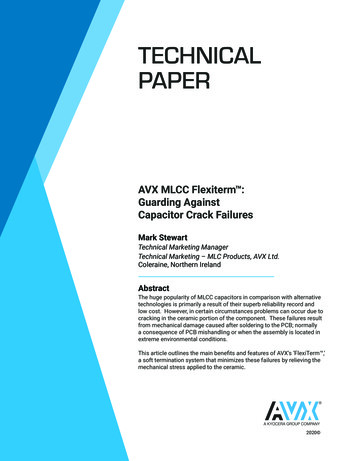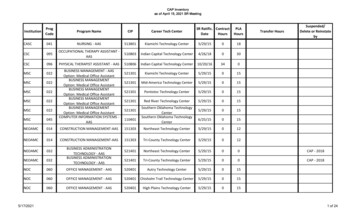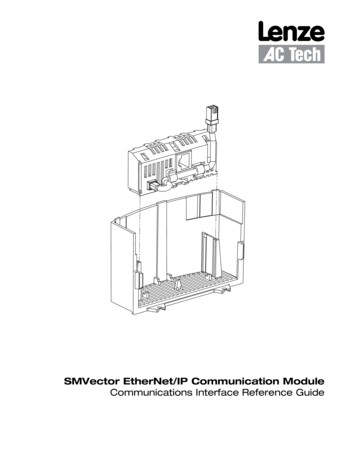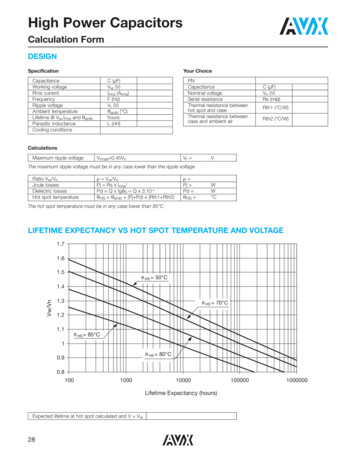
Transcription
TECHNICALPAPERAVX MLCC Flexiterm :Guarding AgainstCapacitor Crack FailuresMark StewartTechnical Marketing ManagerTechnical Marketing – MLC Products, AVX Ltd.Coleraine, Northern IrelandAbstractThe huge popularity of MLCC capacitors in comparison with alternativetechnologies is primarily a result of their superb reliability record andlow cost. However, in certain circumstances problems can occur due tocracking in the ceramic portion of the component. These failures resultfrom mechanical damage caused after soldering to the PCB; normallya consequence of PCB mishandling or when the assembly is located inextreme environmental conditions.This article outlines the main benefits and features of AVX’s ‘FlexiTerm ,’a soft termination system that minimizes these failures by relieving themechanical stress applied to the ceramic.2020
AVX MLCC FLEXITERMTM:GUARDING AGAINST CAPACITOR CRACK FAILURESby Mark Stewart, Technical Marketing ManagerTechnical Marketing – MLC Products, AVX Ltd.Coleraine, Northern IrelandThe Cracking ProblemFlexiTermTM Absorbs the StressAs the dominant capacitor technology in terms ofcomponent quantities, the Multilayer Ceramic ChipCapacitor’s (MLCC) popularity with circuit designers isprincipally due to its high reliability record and low cost.However, due to the nature of ceramic material the MLCCbody can be liable to cracking if mishandled duringassembly or used in extreme environments. For thisreason cracking in an MLCC body is the most commonmode of failure for PCB mounted MLCC components.AVX recognized that there was a need to improve theMLCC’s mechanical performance to provide a morereliable product when severe external forces are beingapplied to the component. FlexiTermTM was developedas an additional flexible termination layer added to thecomponent thus ensuring electrical integrity is maintainedwhile external forces are applied (Figure 2). FlexiTermTMis used in conjunction with BME (Base Metal Electrode)technology. This offers the advantage of eliminating theproblems of high material cost associated with PdAgcapacitor technology as well as providing increasedreliability performance. The improvement in flex andthermal performance results in a more reliable solutionwhere board flex in manufacturing is a problem or wherethe component is operated in extremely demandingenvironments.Fractures in MLCC components are most commonly adirect consequence of flexing the PCB board wherethe component is attached. This flexing may resultfrom mechanical induced forces found in assemblymanufacturing as well as in harsh operating conditionsin the field. In the worst case a low resistance fracturefailure can lead to extremely high temperatures when thecomponent is connected to a power line and with amplecurrent supply could result in catastrophic damage to theimmediate area of the circuit board.Typically, board flex induced cracks initiate where theceramic/termination interface is soldered onto the PCB andpropagates to a point approximately halfway up the heightof the ceramic capacitor termination. An example of this isshown in Figure 1.Mismatching coefficient of thermal expansion (CTE)between the component and PCB can also cause excessiveforces at the connection site of the dissimilar materials.This can particularly be an issue in power converter bricksdue to large fluctuations in temperature caused by varyingload conditions. FlexiTermTM’s flexible properties reducethe risk of failure to the system by lessening the stresseson the component.Figure 1. Standard Termination MLCC exhibitingTypical Board Flex CrackFigure 2. Additional FlexiTermTM Layer forIncreased Resistance to Mechanical FlexureAVX offers FlexiTermTM on a wide range of values in X7Rdielectric including automotive, power supply inputcapacitors as well as with standard commodity products.1
month in detection, containment and repair are notuncommon. Solutions such as redesign of component layoutcan also have a long turnaround time before obtainingconfirmation that it is a solution to the problem.Applications Needing Protectionfrom Fracture FailuresMLCC fractures can be most problematic in high cost andhigh power applications since a greater amount of damageis possible on a circuit where higher current is available.High-risk applications include Automotive, PowerSupplies, Converters, Telecoms, Basestations, PCs andLaptops, PDAs, Medical and Instrumentation. In generalall types of PCB assemblies are susceptible to ceramiccapacitor failures during manufacture and additionallysome are vulnerable to failures because of harsh workingenvironments.The fracture failure can sometimes be so common to acontract manufacturer and understood to be caused duringassembly that they do not highlight the problem to theirsupplier or customer. In some cases only the qualityengineer is aware of the extent of the problem and casesare known where the failures are not recorded or trackedby production staff. This may occur because it is presumedthat the more severe failures can be located at end ofassembly testing, a critical error since component fracturesmay not initially be obvious using capacitance and Q factortesting. The actual MLCC component’s operation may notdegrade until moisture ingresses into the crack causing alow resistance path between adjacent electrodes, this mayonly become apparent after exposure to moist atmosphere.For this reason some ceramic fractures may be found incapacitors by measuring its change of insulation resistance(IR). IR testing is a standard test used to confirm acapacitors proper operation but is as a rule not possibleonce the component is attached to the circuit board.The automotive sector is an example of an industry whereceramic capacitor failures are already widely recognized asbeing a critical failure in their applications. Emergingtrends in automotive electronics include the drive for higherlevels of reliability at the component level, miniaturization,increased functionality, and the placing of integratedelectronics in high temperature, harsh environments in thecar such as the engine, clutch, and gearbox. Automotiveelectronic system manufacturers have hence played animportant role in recognizing the limit of the ceramiccapacitor and helped define the requirements for a moresuitable MLCC product for the future.FlexiTermTM –The Solution to CrackingPower supplies and converters are technologies that alsorequire protection from MLCC crack failures. Advancesmade in ceramic capacitor technologies have led to anincrease in their use in power supply applications; thesedevelopments include higher available capacitance valuesand lower Equivalent Series Resistance (ESR) comparedto alternative capacitor technologies.AVX found that to stop ceramic fractures from occurringthe structure of the capacitors termination needed to beflexible and after much research and development,“FlexiTermTM” was identified. The new high conductivitytermination material with flexible properties was added tothe AVX standard X7R dielectric ceramic capacitor toproduce the new range of FlexiTermTM MLCC capacitors.This Flexible Termination is specifically designed toenhance the mechanical and temperature flexureperformance of the component preventing failures inthe system due to cracking.Failure of a component such as an MLCC due tomechanical or thermo-mechanical stress can compromisecritical safety systems and halt the operation of the entiresystem in many applications. In addition, the cost of failurein high-end modules and units is also significant toautomotive and power supply manufacturers bothfinancially and vitally to their reputations. Moredisturbingly, an MLCC shorted on a 48V or even 12V linesupplied with a few amps, which is easily available from acar battery, can heat to around 1000 degrees Celsius,potentially causing substantial damage!Examples exist where experienced capacitor users whoaccepted high rates of board flex failures due to unknowncauses in manufacturing removed the failures completelyby replacing the capacitors with parts from the AVXFlexiTermTM range.Cost is always a determining factor on whether a circuitdesigner or manufacturing engineer can use a certaincomponent. It may rely on the quality engineer todetermine the real cost saving in cases where board flexfailures can be removed by introducing the FlexiTermTMcomponent. This is more appropriate for lower cost, smallvalue capacitors. Where capacitance values are larger withcorresponding increase in price the cost of FlexiTermTMbecomes less significant. For the high capacitance valueinput capacitor range AVX provides FlexiTermTM as standardsince the additional material and manufacturing cost is asmall proportion of the overall cost of the component.Addressing the Fracture FailuresFailure due to a fracture is not restricted to particular MLCCmanufacturers but across the range of minor as well as majorsuppliers. Causes of failure are normally well understood bythe electronic assembly manufacturer. The most commonareas for failure are PCB depanelization, componentplacement, board assembly insertion sections and whereMLCCs are placed too close to the edge of the PCB.Measures to reduce failures are well documented but whenthis type of failure arises it can be unexpected, a long time todetection and difficult to determine root cause. Examples ofassembly manufacturers spending thousands of dollars perWhile other manufacturers are known to offer ceramiccapacitors with a flexible termination technology, AVX is2
currently the only manufacturer to offer this type oftechnology on a BME capacitor providing a lower costalternative to those components using precious metalmaterials. Meanwhile, some manufacturers are offering analternative method of flexure protection. This method usesan adapted internal electrode design where an increasedgap is made between the end of the electrode and side ofthe chip. This design helps to reduce low resistance andshort circuit failures due to the higher chance of the crackonly passing through one polarity group of electrodes andnot the worst-case scenario of shorting through bothpolarities. However, depending how high the crackpropagates through the component an increasing loss ofcapacitance will be incurred due to the disconnection ofelectrodes. Another disadvantage of this technique is thatthis type of component may not be available in maximumcapacitance values and where available the thickness isincreased above the normal dimension to compensate forthe lost capacitive area at the ends of the electrodes.attention. Shortly thereafter an Automotive ElectronicsCouncil Component Technical Committee created aqualification requirement and test method in the documentAEC-Q200 to precisely define stress test qualifications forpassive components.AEC-Q was used by AVX to evaluate the ability of acapacitor to withstand mechanical stress; two relevanttests used to compare standard termination withFlexiTermTM are the board bend flex test and temperaturecycling test.The bend test requires a component to be reflow solderedto a printed circuit board and placed on two supports 90mmapart as shown in Figure 3. The board is then bent up to10mm at 1mm per second. Once the load is applied, thedeflection where the part starts to crack is recorded usinga highly sensitive current detection circuit or by sectioningthe component after a defined bend deflection. TheAEC-Q200 specified flexure test defines a minimumflex requirement of 2 mm.How FlexiTermTM WorksFlexiTermTM is a flexible termination comprising aconductive polymer that ensures electrical integrity ismaintained during and after external forces are applied tothe component. FlexiTermTM is used in conjunction withBME (Base Metal Electrode) technology. BME replacesthe higher cost Palladium-Silver (PdAg) with a Nickel (Ni)electrode and Copper (Cu) termination. FlexiTermTM isachieved by coating the Cu termination with conductivepolymer, which is then plated with Nickel (Ni) and Tin (Sn).Figure 3. Board Bend Flex Test per AEC-Q200Test QualificationThe board bend flex test found that AVX FlexiTermTMparts do not fail when flexed to 5 mm. This improvementgives a 2 to 4 times increased bend resistance compared tostandard capacitor technology.Resistance to mechanical failures are provided byFlexiTermTM’s ability to reduce the transfer of mechanicalstress exerted on the component body. In normaloperation this prevents the component from beingdamaged by board flex during manufacture as well asdamage from the environment caused by board flexing,vibration and temperature expansion.Temperature Cycling is another automotive test conductedby AVX to determine the resistance of a part to extremesof high and low temperatures by alternative exposure tothose extremes. The component is mounted to an FR4PCB allowing the test to simulate the stresses caused bythe mismatch in temperature expansion between thecomponent and the circuit board. AEC-Q200 requires thestandard ceramic X7R capacitor to withstand 1000 cyclesfrom -55 to 125 degrees Celsius. 3000 cycles are achievablefrom parts in the FlexiTermTM range without damage tothe component. This means that FlexiTermTM offersimproved reliability performance in applications wherethere is extreme temperature variation, e.g. outside cabincircuits in automotive and aviation applications.While FlexiTermTM offers much better mechanical andthermo-mechanical performance, it is designed so that ifthere were to be a failure due to flexing, it would be in thetermination area and in open mode. Open circuit is apreferred failure mode as it stops the supply of current,removing the possibility of circuit damage that may arisefrom a short circuit failure. This is especially important onpower lines where failure could involve fire damage due toshort circuit. In the case of FlexiTermTM the open circuitoccurs in a small area of the termination meaning little orno degradation to the capacitor’s performance.The equivalent series resistance (ESR) is an importantparameter where high rms-current carrying capability isrequired. An investigation to determine if any change inESR occurred in the capacitors with FlexiTermTM wasperformed by AVX using the long-term reliability tests,operational life and temperature cycling both defined bythe AEC-Q200 specification. The components ESR valuewas measured at intervals throughout the duration of thelong-term tests and found not to change throughout therecommended test duration. This proved that theinterconnection between the electrodes and terminationshowed no degradation even after severe operationconditions of voltage and temperature.Testing FlexiTermTM’sMechanical FlexibilityElectronic component performance is such a concern inautomotive electronics that Ford, Chrysler and GMcreated the Automotive Electronics Council in 1993. Thegoal of this council is to create common qualificationspecifications as a possible way to improve supplier3
Further, the performance offered by FlexiTermTMtechnology also lends itself to applications that aredemanding higher levels of reliability such as in telecomservers, mobile phone basestations and remotemeasurement systems as well as in high-end valueequipment where failure implies high costs.Board Flex Test in Terms of StrainMeasurement of the external forces exerted on acomponent during board flex can be demonstrated usinga strain gauge. A maximum permitted strain value cantherefore be supplied for MLCC components allowing asafe margin in the manufacturing process window to beapplied. The increased resistance to strain provided byFlexiTermTM offers the circuit designer and assemblyprocess engineer a guide to component choice where highlevels of strain cannot be avoided or where safety is criticalto the application.Expanding FlexiTermTM ProductRangeA large range of standard X7R MLCCs are available withthe option of FlexiTermTM. This was first provided to ourautomotive customers but are now provided to otherproduct manufacturers such as instrumentation, powersupplies, etc. AVX’s continuous investment in Research& Development and enhanced manufacturing techniquesallows the expansion of the High CV Ceramic capacitorline. As higher value X7R capacitors become available indifferent case sizes they will also be included in theFlexiTermTM range.Strain may be calculated for a PCB board bent in a uniformradius. This provides a relationship between the strainsubjected on a component and the test method specified byAEC as a deflection in mm. The calculation is verified bya strain gauge measurement on the board bend flex testboard and is presented in Figure 4. In the applicationstrain may be measured at the PCB’s high flexure site byattachment of a Strain Gauge to the component side of thePCB. The defined strain requirement for the capacitor cannow be compared with the components allowable strainand if required an alternative such as ‘FlexiTermTM’ canreplace standard components for improved reliability.The AVX MLCC high capacitance products are suited to awide range of applications in power distribution systems.The X7R 50V and 100V ranges have primarily beendeveloped for use as input filters in a DC-DC converterwhere the inherent low ESR of the MLCC parts reducesthe ripple voltage across the input terminals. The additionof FlexiTermTM to the input capacitor range at no extra costoffers AVX components the distinct advantages ofexcellent Bend Test and Temperature Cyclingperformance with obvious benefits to circuit designers.Other uses for “input capacitors” include Power overEthernet applications.ConclusionSignificant progress has been made in the development ofenhanced termination systems to reduce MLCC failurescaused by mechanical damage. Polymer based FlexiTermTMsystems offer increased system performance and reliabilityby minimizing stresses transferred to MLCCs. This resultsin greater than 2x standard board deflection capabilitywith enhanced termination technology devices.Additionally, this translates into significant temperaturecycling capability (roughly 3x standard terminationdevices). Applications for FlexiTermTM now extend wellbeyond automotive sectors with significant volume usedin Power Supplies, Telecoms, Basestations andInstrumentation.Figure 4. Calculated and Measured Strain versus BoardBend Test DeflectionReliability Reduces CostsThe key benefit of FlexiTermTM is its ability to deliverexcellent mechanical and thermo-mechanical performanceleading to higher levels of reliability.The location of a component on the printed circuit boardmay influence the level of thermal or mechanical stressto which the component is exposed. FlexiTermTM enablesmanufacturers to use a wider process window with respectto board layout. This may, in some cases, alleviate designand manufacturing constraints and expensive redesigns ofa problematic circuit board.4
NORTH AMERICATel: 1 864-967-2150CENTRAL AMERICATel: 55 11-46881960ASIATel: 65 6286-7555EUROPETel: 44 1276-697000JAPANTel: 81 740-321250NOTICE: Specifications are subject to change without notice. Contact your nearest AVX Sales Office for thelatest specifications. All statements, information and data given herein are believed to be accurate and reliable,but are presented without guarantee, warranty, or responsibility of any kind, expressed or implied. Statementsor suggestions concerning possible use of our products are made without representation or warranty that anysuch use is free of patent infringement and are not recommendations to infringe any patent. The user shouldnot assume that all safety measures are indicated or that other measures may not be required. Specificationsare typical and may not apply to all applications.
(IR). IR testing is a standard test used to confirm a capacitors proper operation but is as a rule not possible once the component is attached to the circuit board. FlexiTermTM - The Solution to Cracking AVX found that to stop ceramic fractures from occurring the structure of the capacitors termination needed to be










